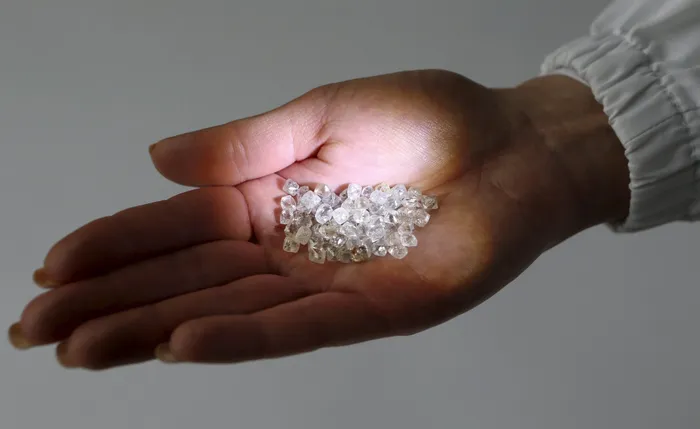Expert tips on how to spot real diamonds from fakes

An employee shows rough diamonds at a sorting centre, owned by Alrosa company, in Moscow, Russia. Picture: REUTERS/Sergei Karpukhin/Files.
In a world full of dupes, it can be challenging to distinguish between a real diamond and a fake one.
Jewellery expert Goodstone reports that diamond scams cost consumers an estimated $8bn per year.
“The fake diamond scam can impact the livelihoods of real diamond mining and trading communities, and weaken economies worldwide,” said jewellery expert Blake Asaad of Goodstone.
“Knowing how to tell real from fake diamonds helps to make a stand against this criminal trade and prevent people from getting hurt by it in their pocket, and all too often, emotionally.”
Asaad suggests the following methods to check if your diamonds are real.
Fog test: Blow on the diamond to see how fast the condensation from your disappears. Real diamonds will disperse the breath fog quickly.
“Your breath fog will disperse faster on a real diamond because of its density compared to a fake diamond. This density makes the stone hard to heat up or cool down; so a real diamond will likely be warmer than a fake, and so condensation is less likely to form on its surface.
“This density is caused by the vast pressure that creates diamonds underground,” Asaad explained.

Water test: Drop the diamond into water and if it sinks quickly, it's likely a real diamond. If it floats or sinks slowly, it's likely fake.
“Again, this is a product of a real diamond’s density, which makes it heavy, causing specific gravity to make it sink faster. Corks demonstrate this.”
Heat test: Heat the diamond with an open flame for about 40 seconds, then drop it into cold water. If it breaks, it's likely fake. However, this method can damage the stone and is generally not advisable.
“This happens because a fake diamond has stress lines in it that real diamonds don’t have. Again, this is because of the way real diamonds were created.”
Blacklight: Hold the diamond under a black light (a lamp that emits ultraviolet light, which is invisible to the human eye. If the jewel emits a blue light, it's likely real.
“The black light test works because of spectroscopy, which assesses the molecular structure of the object by revealing the wavelengths of light (electromagnetic radiation) it absorbs, refracts, and reflects.”
Refractivity test: Use the news to check how the diamond refracts light. To test the diamond’s refractivity, place the stone on a newspaper with lots of lettering. Are the letters easy to read or distorted?
Real diamonds refract light, causing it to bend and curve when you move it. Fake diamonds don’t do this. If the diamond is real, you won’t be able to read the text.
“Like the black light test, this is a product of the molecular structure of the diamond, which is a product of its origins,” said Asaad.
Related Topics: